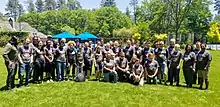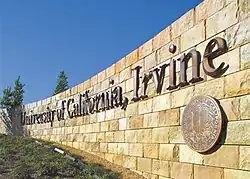Center for Chemistry at the Space-Time Limit
Center for Chemistry at the Space-Time Limit or CaSTL Center is a National Science Foundation’s (NSF)[1] Centers for Chemical Innovation (CCI).[2]
| Motto | Visualize Single Chemical Event |
|---|---|
| Established | 2008 |
| Director | Vartkess Ara Apkarian |
| Location | Irvine, California |
| Campus | University of California, Irvine (HQ). Partner Institutions: Northwestern University, University of Pittsburgh, PennState, University of Utah. |
| Website | www.castl.uci.edu |

The CaSTL Center was established through a cooperative agreement between NSF and University of California, Irvine in 2008.[3] Vartkess Ara Apkarian, a Professor of Chemistry at the University of California Irvine, is the Director of the Center.[4][5] Membership of the Center include noted researchers in nanoscience such as Richard Van Duyne, Hrvoje Petek, Wilson Ho, H. Kumar Wickramasinghe, George Schatz, Eric Potma, Lasse Jensen, Matt Law, Nien-Hui Ge, Jennifer Shumaker-Parry, Ruqian Wu.
Mission
The mission of the CaSTL Center is "develop the essential science and technology to probe single chemical events in real space and time".[6] CaSTL researchers proposed and developed a new tool, called Chemiscope,[7] a chemist's microscope, to accomplish this goal.
Accomplishments
Microscopy with a Single Molecule Scanning Electrometer
CaSTL researchers developed experimental & theoretical tools to image electrostatic fields and charge distributions with sub-nanometer spatial resolution.[5] They demonstrated the first Single Molecule limit in miniaturization of microElectroMechanical Systems (SMEMS).[8] They demonstrated that vibrations of a single tip-attached carbon monoxide molecule (CO) serves as a force sensor and electric-to-mechanical force transducer with signal optically relayed through tip-enhanced Raman spectroscopy (TERS). This discovery enabled researchers to access electric fields, capacitance and conductivity within molecules, which will impact fields ranging from molecular electronics to catalytic chemistry.
Imaging Vibrational Normal Modes of Single Molecules
Internal vibrations of molecules determine the structural transformations that determine chemistry such as reactivity. A CaSTL team led by Vartkess Ara Apkarian reported measured the vibrational normal modes of a single cobalt-tetraphenylporphyrin molecule on a copper surface with atomically confined light.[9] This study used a variant of Tip-Enhanced Raman Spectroscopy to measure vibrational spectra within a single molecule. While chemist's use a variety of tools, including Infrared spectroscopy, to measure vibrations of molecules, however, measuring the normal modes of a single molecule has been elusive because microscopy with atomistic resolution requires a magnification nearly three orders of magnitude higher than the optical diffraction limit.[10][11]
Broader Impacts
CaSTL Center organized several scientific events such as symposia, workshops, summer schools on single molecule chemistry. Noted among these are 2018 Telluride Workshop on Molecular Videography[12] and a symposium themed Toward Chemistry in Real Space and Time at the 2019 Fall Meeting of the American Chemical Society.
Informal Science Education
A science video game titled Bond Breaker was developed by CaSTL scientists in collaboration with TestTubeGames. This game become very popular and featured on the front page[13] of Scientific American. This game is currently available on several gaming platforms across the world. A Classroom version of the game, Bond Breaker - Classroom Edition,[14] based on Next-Generation Science Standards, was released in 2019. This video game consists of a series of game levels, animations, quizzes and NGSS Lesson plans. The characters in this game were chosen to promote diversity and equity in STEM disciplines.
Science Animations
CaSTL scientists helped the development of a series of science animations, such as What is an Atom and How Do We Know?,[15] What are Atoms Made of?,[16] What is a Molecule?,[17] and How to See a Virus, [18] explaining the basic concepts of nanoscience to the broader public.
CaSTL - ASU Pathways Program
CaSTL scientists partnered with the Albany State University to provide Summer Research Experience to the underrepresented undergraduate students with the support from University of California, Office of the President. This program later attracted participation from other HBCU institutions such as Hampton University, Tuskegee University.
References
- "NSF - National Science Foundation". nsf.gov. Retrieved 21 January 2019.
- "Centers for Chemical Innovation | NSF - National Science Foundation". www.nsf.gov. Retrieved 21 January 2019.
- "NSF Award Search: Award#0802913 - The Center for Chemistry at the Space-Time Limit (CaSTL)". www.nsf.gov. Retrieved 21 January 2019.
- "V. Ara. Apkarian | ps.uci.edu". ps.uci.edu. Retrieved 21 January 2019.
- "Scientists push microscopy to sub-molecular resolution". phys.org. Retrieved 21 January 2019.
- "Mission". CaSTL. 2012-02-01. Retrieved 2019-03-26.
- "Chemiscope - Science Nation | National Science Foundation". www.nsf.gov. Retrieved 2019-03-26.
- Apkarian, V. Ara; Jensen, Lasse; Chen, Xing; Tallarida, Nicholas; Lee, Joonhee (2018-06-01). "Microscopy with a single-molecule scanning electrometer". Science Advances. 4 (6): eaat5472. Bibcode:2018SciA....4.5472L. doi:10.1126/sciadv.aat5472. ISSN 2375-2548. PMC 6025905. PMID 29963637.
- Apkarian, V. Ara; Nicholas Tallarida; Crampton, Kevin T.; Lee, Joonhee (April 2019). "Visualizing vibrational normal modes of a single molecule with atomically confined light". Nature. 568 (7750): 78–82. Bibcode:2019Natur.568...78L. doi:10.1038/s41586-019-1059-9. ISSN 1476-4687. PMID 30944493. S2CID 92998248.
- April, Derek Lowe 10; 2019 (2019-04-10). "Vibrational Modes, For Real". In the Pipeline. Retrieved 2019-04-11.CS1 maint: numeric names: authors list (link)
- Ru, Eric C. Le (April 2019). "Snapshots of vibrating molecules". Nature. 568 (7750): 36–37. Bibcode:2019Natur.568...36L. doi:10.1038/d41586-019-00987-0. PMID 30944489.
- "Workshop Details | TSRC". www.telluridescience.org. Retrieved 2019-07-21.
- Ouellette, Jennifer. "New Bond Breaker Game Puts You in the Proton's Seat". Scientific American Blog Network. Retrieved 2019-07-21.
- "Bond Breaker - Classroom Edition | TestTubeGames". testtubegames.com. Retrieved 2019-07-21.
- Stated Clearly (2018-09-18), What Is an Atom and How Do We Know?, retrieved 2019-07-21
- Stated Clearly (2019-01-03), What Are Atoms Made Of?, retrieved 2019-07-26
- Stated Clearly (2019-06-26), What Is a Molecule?, retrieved 2019-07-26
- How To See A Virus!, retrieved 2020-06-03
